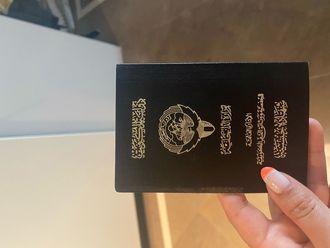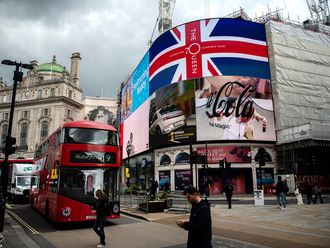
New Delhi: Director of the Centre for Science and Environment (CSE) Sunita Narain is once again up in arms, this time with producers of honey. She has shattered the myth about natural and pure honey by finding antibiotic contamination in it.
She is passionate about her work and all her goals and dreams revolve around making a difference in the country. Used to having multi-pronged fights, Narain has been associated with several issues including pesticides in soft drinks, cleaning cities' polluted air by introducing Compressed Natural Gas (CNG) and adopting rainwater-harvesting systems.
A stickler for justice, she says, "I'm happy that CSE is able to create awareness among the masses on varied issues. One feels content when public perception changes."
The tireless crusader talks to Gulf News in an exclusive interview.
GULF NEWS: Does CSE stumble upon issues like Coke, Pepsi and now honey, or are you always on the go researching products? What is the basis of a particular product to be researched?
SUNITA NARAIN: We have never stumbled upon issues. Our Pollution Monitoring Lab is well equipped to test air, water and food for contamination and pollution. And we do tests in public interest and for communities which come to us with their requests. In the past we have tested bottled water and soft drinks for pesticide residue, cases of endosulfan contamination, edible oil for transfats and toys for phthalates. The genesis of each research project has been different. For instance, CSE had done the study on bottled water in 2003. After the study was published and accepted, people approached us to ask if we could test other food products which had water in them. These included soft drinks.
In the case of honey, we began specifically by looking at how the quality of a natural product like honey is regulated in and outside the country. We commenced researching on it from July 2009. And found antibiotics in various brands of honey.
Antibiotics are medicines. So why are they bad in honey?
Studies have pointed out that chronic exposure to antibiotics, meaning, doses taken in small amounts on a daily basis for a long period can lead to various health problems. For instance, exposure to oxytetracycline, one of the antibiotics tested by the CSE lab, can lead to blood-related disorders and liver injury. But more importantly, antibiotics in honey and perhaps other foods as well, have the potential to generate large-scale antibiotic resistance, leading to a collapse of health care systems and medications.
International regulations consider honey to be a natural product. We consume it because we believe it's pure and will do us good. But there is no reason why we should be finding human-made antibiotics in it. Regulators in the European Union and the US say antibiotics in honey are unauthorised and therefore illegal, unless there is a standard regulating their levels. India does not have any such standards for domestically marketed honey.
Where does honey get antibiotics from?
The beekeeping industry uses antibiotics to control and prevent outbreaks of diseases in honey bees, and as growth promoters to increase production. These antibiotics are finding their way into that spoonful which reaches the householder's table. This is also because the biodiversity of bees has changed. The Indian bee, which is more adapted to natural environments, has been replaced by the more productive European bee called apis mellifera. At the same time, the trade of honey collection has also changed from small producers to large cartels of honey producers, contracting small producers and pushing for high productivity and profits.
Why, how and when did the Indian bee get replaced by the more productive European bee?
In 1965, the honey industry in India received a boost when the Punjab Agriculture University introduced the Italian bee species, apis mellifera. Till then, honey was sourced from bee colonies of native species like the Indian rockbee. The new bee species soon replaced the native bees in the apiaries of Jammu and Himachal Pradesh, Punjab, Haryana and Uttar Pradesh as the honey yield from their hives was higher.
Which brands have tested positive for antibiotics?
The tested samples were bought randomly from various markets in Delhi in July 2009. Of the 12, 10 were Indian brands and two were imported. Leading honey producers including Dabur, Baidyanath, Patanjali, Ayurveda, Khadi and Himalaya had two to four antibiotics in their products. This is much above the stipulated standards. Actually, the prevalent practice is to collect honey from different sources and then blend it before packing and distributing for sale. This brings into question the issue of traceability of honey. What is strange is the reticence of Indian regulators towards setting and enforcing standards. It's like saying we are Indians, we don't need regulations!
Is there any brand of honey that is free from antibiotics?
Yes, Hitkari's results were negative in our tests.
How has Hitkari managed to avoid antibiotics in honey? Is it incidental? Or is it using some other kind of honey bees?
It might be completely incidental. It is a small company involved in the seasonal honey business. We do not know where it sources its honey from.
Is honey imported from other countries free from antibiotics?
Unfortunately not. The two foreign brands tested by us from Australia and Switzerland had high levels of antibiotics and would certainly be illegal in their own countries.
These are Capilano Pure and Natural Honey of Capilano Honey Limited, the market leader in Australia, exporting honey to over 40 countries and Nectaflor Natural Blossom Honey of Narimpex AG with its production site in Biel, Switzerland.
This proves there are double standards in regulations and foreign brands sold in India are contaminated. It is also clear that they are taking advantage of the lack of regulations in India. After all, if our government does not care about the health of its people, why should these companies care? We have standards for antibiotic contamination in the honey we export. The government tests and certifies that exported honey meets health and safety regulations. But we do not have any standards for domestic honey.
Which antibiotics are found in honey?
The study found six high levels of antibiotics. These include the banned chloramphenicol to broad spectrum ciprofloxacin and erythromycin in almost all brands sold in the market. The other three are oxytetracycline, ampicillin and eurofloxacin.
What are the different standards set up for exporting honey?
The Export Inspection Council (EIC) has set antibiotic standards for the honey that is exported. This is referred to as Level of Action that means the limit beyond which a sample is deemed non-compliant and rejected for exports. An elaborate system of monitoring called Residue Monitoring Plan has also been put in place, and the EIC, under the Union Ministry of Commerce and Industries, has been entrusted with the task of checking exports. But the country suffers in case of improper monitoring or checks.
Have there been instances when Indian honey faced problems entering the world markets?
Yes. In June 2010, the EU banned Indian honey from entering any of its 27 member countries because our consignments were contaminated with antibiotics and heavy metals. But these monitoring, checks and norms do not apply to honey available in the domestic market. There are no reports on antibiotic contamination of honey consumed within the country. Food safety regulations are supposed to be monitored by the Food Safety and Standards Authority of India. But the Authority, despite being in existence for almost four years, has failed consumers.
It works only for the benefit of big business to undermine our bodies and our health. Our study on honey is only one indicator of the takeover of our food business and tells us that action is needed fast. We cannot allow business to be more important than the food we eat.
- Sunita Narain was born to mother Usha and father Raj Narain in Delhi on August 23, 1961.
- Studied at Loretto Convent followed by Modern School.
- Did her graduation by correspondence from Delhi University 1980-1983.
- Research work at the Vikram Sarabhai Institute for Development and Research, Ahmedabad 1980-81.
- Had a short stint doing audio-visuals on environmental issues at the Natural History Society, Mumbai 1981.
- Joined the Centre for Science and Environment as co-researcher in 1982.
- Appointed deputy director in 1993 and took over as director in 2000.
- Received several awards including the Padma Shree in 2005 by the Government of India.
- Received Stockholm Water Prize 2005 in Sweden.
- Publisher and editor of the fortnightly magazine Down To Earth.
Background: Summary of education and career












